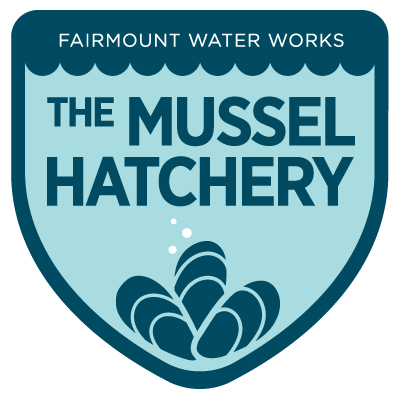Freshwater Mussel Hatchery

We are having a great freshwater mussel propagation season this year and propagated over 33,500 mussels! We invite you to visit our Mussel Hatchery Exhibition and Aquatic Field Station at the Fairmount Water Works Interpretive Center to learn about mussels, or alternatively, please enjoy the Mighty Mussel Virtual Experience!
This project was made possible by generous support from The Pew Center for Arts & Heritage and the Philadelphia Water Department with additional support from The McLean Contributionship and the Pennsylvania Department of Conservation and Natural Resources.
The Mussel Hatchery
With the help of a multidisciplinary team of experts, this Aquatic Field Station is designed for scientific discovery and creative exploration and expression. Get ready to dive in!
The Mussel Hatchery has been created to raise awareness about mussels and the vital need for revitalizing and protecting our freshwater systems for the health of all living things—including you and me. Our goal is to propagate new mussels and boost diminished populations in the Delaware River watershed.
Within our mussel hatchery, we are putting a theory into practice on a small scale. Through science, art, and new technologies, we demonstrate the extent to which mussels could contribute to the restoration of our degraded freshwater system. This experiment will always be in flux—much like the natural environment that inspires us.
“They’re the ultimate underdogs. They get no respect. But when you see them doing their thing, it’s like, ‘Whoa!'”
Danielle Kreeger, former Science Director, Partnership for the Delaware Estuary
Experience a living science laboratory in action, get a behind-the-scenes look at the life and times of a freshwater mussel, and enjoy a unique view of the ever-changing Schuylkill River habitat. The hatchery will demonstrate the ecological benefits of freshwater mussel restoration in improving the health of our waterways.
About Freshwater Mussels
Freshwater mussels are bivalve mollusks, just like oysters, clams, and saltwater mussels. This means they have two hard shells to protect their soft bodies. Like other bivalves, mussels can improve water quality, provide food for bottom critters, and contribute to healthy habitats in our local waterways.
The bottom of rivers, streams, lakes, and ponds are where mussels make their home. Mussels are hard to see because they burrow down and blend in with rocks and leaves. In healthy habitats, mussels live close together and create large mussel “beds.” Healthy beds can have many thousands of mussels, with many different species living together in a single acre.
We should all care about mussels because they are natural water filters AND are among the most imperiled creatures on the planet.
Freshwater mussels are found on every continent except Antarctica, and there are more than 700 species worldwide. Nearly 300 of these species live in North America, making us the world’s biodiversity hotspot for freshwater mussels! Unfortunately, over 70% of them are at risk of extinction. Freshwater mussels are one of the most imperiled animals in North America as well as locally in the Delaware River basin.
Historically, over a dozen species were found throughout our streams and lakes. Today, only a few are readily found in New Jersey, Pennsylvania, and Delaware, and their populations are declining throughout our watershed.
Visit us often and watch as these fascinating creatures grow and are eventually placed in our region’s ponds, streams, and rivers to do their important work!



